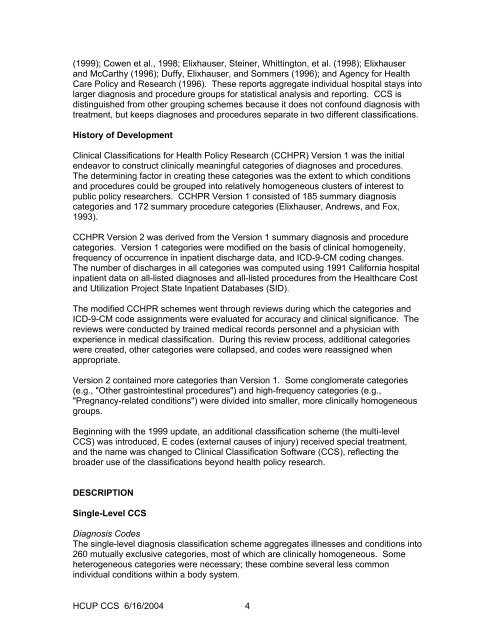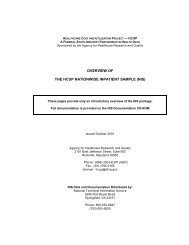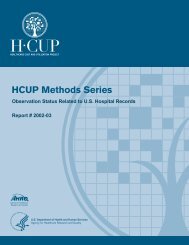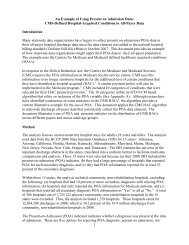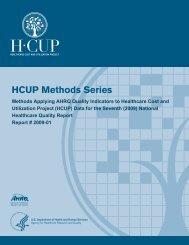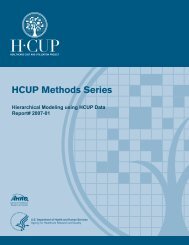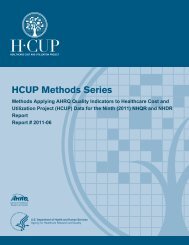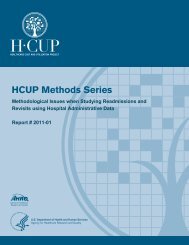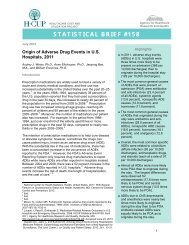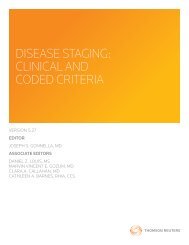HCUP Methods Series - Agency for Healthcare Research and Quality
HCUP Methods Series - Agency for Healthcare Research and Quality
HCUP Methods Series - Agency for Healthcare Research and Quality
Create successful ePaper yourself
Turn your PDF publications into a flip-book with our unique Google optimized e-Paper software.
(1999); Cowen et al., 1998; Elixhauser, Steiner, Whittington, et al. (1998); Elixhauser<strong>and</strong> McCarthy (1996); Duffy, Elixhauser, <strong>and</strong> Sommers (1996); <strong>and</strong> <strong>Agency</strong> <strong>for</strong> HealthCare Policy <strong>and</strong> <strong>Research</strong> (1996). These reports aggregate individual hospital stays intolarger diagnosis <strong>and</strong> procedure groups <strong>for</strong> statistical analysis <strong>and</strong> reporting. CCS isdistinguished from other grouping schemes because it does not confound diagnosis withtreatment, but keeps diagnoses <strong>and</strong> procedures separate in two different classifications.History of DevelopmentClinical Classifications <strong>for</strong> Health Policy <strong>Research</strong> (CCHPR) Version 1 was the initialendeavor to construct clinically meaningful categories of diagnoses <strong>and</strong> procedures.The determining factor in creating these categories was the extent to which conditions<strong>and</strong> procedures could be grouped into relatively homogeneous clusters of interest topublic policy researchers. CCHPR Version 1 consisted of 185 summary diagnosiscategories <strong>and</strong> 172 summary procedure categories (Elixhauser, Andrews, <strong>and</strong> Fox,1993).CCHPR Version 2 was derived from the Version 1 summary diagnosis <strong>and</strong> procedurecategories. Version 1 categories were modified on the basis of clinical homogeneity,frequency of occurrence in inpatient discharge data, <strong>and</strong> ICD-9-CM coding changes.The number of discharges in all categories was computed using 1991 Cali<strong>for</strong>nia hospitalinpatient data on all-listed diagnoses <strong>and</strong> all-listed procedures from the <strong>Healthcare</strong> Cost<strong>and</strong> Utilization Project State Inpatient Databases (SID).The modified CCHPR schemes went through reviews during which the categories <strong>and</strong>ICD-9-CM code assignments were evaluated <strong>for</strong> accuracy <strong>and</strong> clinical significance. Thereviews were conducted by trained medical records personnel <strong>and</strong> a physician withexperience in medical classification. During this review process, additional categorieswere created, other categories were collapsed, <strong>and</strong> codes were reassigned whenappropriate.Version 2 contained more categories than Version 1. Some conglomerate categories(e.g., "Other gastrointestinal procedures") <strong>and</strong> high-frequency categories (e.g.,"Pregnancy-related conditions") were divided into smaller, more clinically homogeneousgroups.Beginning with the 1999 update, an additional classification scheme (the multi-levelCCS) was introduced, E codes (external causes of injury) received special treatment,<strong>and</strong> the name was changed to Clinical Classification Software (CCS), reflecting thebroader use of the classifications beyond health policy research.DESCRIPTIONSingle-Level CCSDiagnosis CodesThe single-level diagnosis classification scheme aggregates illnesses <strong>and</strong> conditions into260 mutually exclusive categories, most of which are clinically homogeneous. Someheterogeneous categories were necessary; these combine several less commonindividual conditions within a body system.<strong>HCUP</strong> CCS 6/16/2004 4


